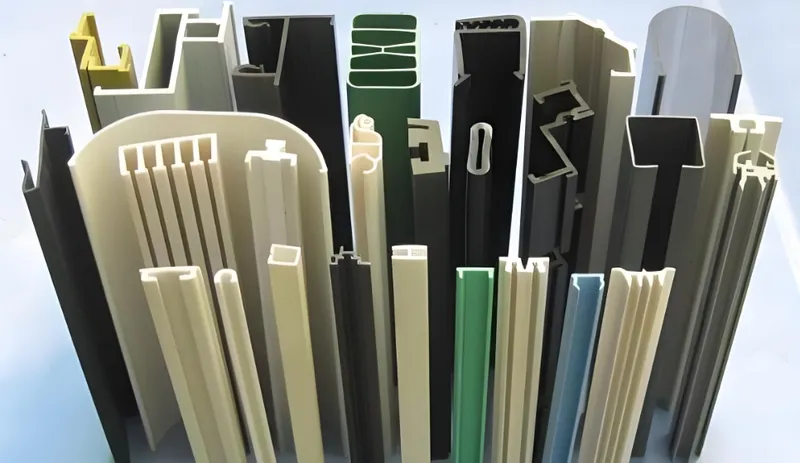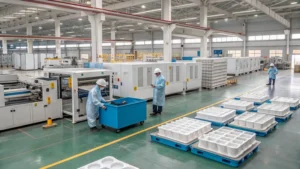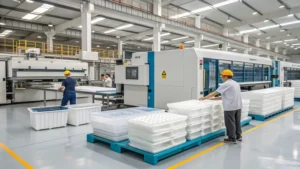
Plastic extrusion machinery powers industries like packaging, construction, and automotive by shaping polymers into pipes, films, and profiles. Yet, unexpected breakdowns, costly repairs, and inconsistent output can disrupt operations. Predictive maintenance (PdM)1 uses data and analytics to forecast equipment failures before they happen, revolutionizing plastic extrusion by slashing downtime, cutting costs, and boosting efficiency.
This blog dives deep into how PdM transforms plastic extrusion machinery, exploring its principles, applications, workflows, and tools. Whether you’re a facility manager or a maintenance technician, this guide will equip you with the knowledge to harness PdM effectively.
Predictive maintenance can reduce downtime by up to 50% in manufacturing.True
Studies show PdM can cut unplanned downtime by 30-50% by addressing issues before they escalate.
Predictive maintenance is too expensive for small operations.False
Though setup costs exist, PdM saves small operations money by preventing breakdowns and extending equipment life.
- 1. What is Predictive Maintenance in Plastic Extrusion Machinery?
- 2. How Does Predictive Maintenance Benefit Plastic Extrusion Operations?
- 3. What is the Workflow of Predictive Maintenance in Plastic Extrusion?
- 4. How Can You Implement Predictive Maintenance in Plastic Extrusion?
- 5. What Technologies are Related to Predictive Maintenance?
- 6. Conclusion
What is Predictive Maintenance in Plastic Extrusion Machinery?
Predictive maintenance (PdM) is a proactive strategy that leverages real-time data to keep plastic extrusion machinery running smoothly.
PdM uses sensors, IoT, and analytics to monitor machinery health, predict failures, and schedule maintenance, minimizing disruptions in plastic extrusion processes.

How It Works
PdM relies on condition-based monitoring2, where sensors track parameters like vibration, temperature, and pressure in components such as screws, heaters, and motors. Advanced algorithms analyze this data to spot anomalies, predict potential failures, and alert teams to act—ensuring maintenance happens only when needed.
How It Compares to Other Strategies
| Maintenance Type | Approach | Pros | Cons |
|---|---|---|---|
| Reactive | Fix after failure | Low upfront cost | High downtime, costly fixes |
| Preventive | Scheduled upkeep | Reduces some failures | May waste resources |
| Predictive | Data-driven action | Cuts downtime, saves costs | Needs investment, skills |
PdM Techniques for Extrusion
-
Vibration Analysis3: Monitors screws and motors for wear.
-
Temperature Monitoring: Tracks heaters and barrels to prevent overheating.
-
Pressure Monitoring: Ensures consistent melt flow in the die.
PdM can extend the lifespan of extrusion machinery.True
By catching issues early, PdM reduces wear, prolonging equipment life.
PdM is only for large manufacturers.False
Small producers can also benefit by avoiding downtime, though planning is key.
How Does Predictive Maintenance Benefit Plastic Extrusion Operations?
PdM transforms plastic extrusion4 by predicting issues before they derail production, offering a smarter alternative to traditional maintenance.
PdM reduces downtime, lowers costs, and enhances quality in plastic extrusion by using data to prevent failures and optimize performance.

Where It Shines
-
High-Volume Lines: Keeps packaging production running without costly interruptions.
-
Critical Equipment: Ensures reliability for high-stakes products like medical tubing.
-
Cost-Sensitive Plants: Cuts repair expenses and boosts machinery longevity.
Pros and Cons of PdM
| Aspect | PdM Advantages | PdM Challenges |
|---|---|---|
| Downtime | Cuts unplanned stops by up to 50% | Setup may briefly disrupt operations |
| Cost | Saves 20-30% on maintenance5 | Requires upfront tech investment |
| Equipment Life | Extends lifespan with timely fixes | Needs regular system updates |
| Quality | Maintains consistent output | False alerts possible if misconfigured |
| Safety | Prevents dangerous failures | Demands skilled data interpretation |
Compared to reactive (fix-it-when-it-breaks) or preventive (routine checks) approaches, PdM uses data to target real needs, though it requires initial setup and expertise.
PdM can reduce maintenance costs by 20-30%.True
By avoiding unnecessary repairs, PdM optimizes maintenance spending.
PdM needs advanced AI to work.False
Basic analytics can still deliver results, though AI boosts accuracy.
What is the Workflow of Predictive Maintenance in Plastic Extrusion?
PdM follows a structured process to keep extrusion machinery humming, from data collection6 to action.
The PdM workflow includes collecting data, analyzing it, alerting teams, performing maintenance, and refining predictions for plastic extrusion machinery.

Step-by-Step Process
-
Data Collection: Sensors on screws, motors, and heaters measure vibration, temperature, and pressure.
-
Data Transmission: Real-time data flows to a central system via IoT or wired setups.
-
Analysis: Algorithms detect patterns or anomalies signaling potential failures.
-
Alerts: Teams get notified (e.g., via text) when action is needed.
-
Maintenance: Repairs or adjustments are made before breakdowns occur.
-
Feedback: Outcomes refine the system, improving future predictions.
Tailoring to Materials
Different plastics demand specific monitoring:

-
HDPE: Focus on temperature due to its high melting point.
-
PVC: Watch temperature and pressure to avoid degradation.
-
PP: Monitor vibration in high-speed setups.
PdM can predict failures with over 90% accuracy.True
Advanced systems with machine learning achieve high precision.
PdM replaces all preventive maintenance.False
It complements, not eliminates, routine checks.
How Can You Implement Predictive Maintenance in Plastic Extrusion?
Getting PdM up and running in your extrusion operation takes planning, tools, and training.

Implement PdM by targeting key components, choosing sensors, setting up systems, training staff, and refining the process for maximum impact.
Implementation Checklist
| Step | Action Items |
|---|---|
| Identify Key Parts | Target screws, motors, heaters |
| Pick Sensors | Match to metrics (e.g., vibration, temperature) |
| Install & Test | Ensure accurate data capture |
| Set Up Data Flow | Use IoT or wired systems for real-time feeds |
| Choose Analytics | Opt for machine learning or simpler tools |
| Train Teams | Teach data reading and response protocols |
| Refine Over Time | Update based on results |
Decision-Making Tips
-
Weigh Costs vs. Benefits: Compare downtime losses to PdM costs.
-
Check Machinery Age: Older units may see bigger gains.
-
Assess Data Readiness: Use existing data or plan new collection.
-
Build Skills: Ensure staff can handle PdM tools.
PdM can be added without major downtime.True
Sensors can often be installed during regular maintenance.
PdM requires all-new machinery.False
It can retrofit existing equipment with sensors and software.
What Technologies are Related to Predictive Maintenance?
PdM doesn’t stand alone—it’s part of a high-tech ecosystem driving smarter manufacturing.
PdM connects with IoT, cloud computing, machine learning, and Industry 4.0 for a data-driven maintenance revolution.

Key Connections
-
IoT & Sensors7: Gather real-time machinery data.
-
Cloud Computing: Stores and crunches massive datasets.
-
Machine Learning8: Sharpens failure predictions.
-
Condition Monitoring: Tracks equipment health continuously.
-
CMMS: Organizes maintenance tasks.
-
ERP Systems: Links PdM to production plans.
-
Industry 4.0: Embeds PdM in smart factories.
PdM is central to Industry 4.0.True
It uses data and connectivity to optimize manufacturing.
PdM needs cloud computing to function.False
On-premise solutions work too, though cloud enhances scalability.
Conclusion
Predictive maintenance is transforming plastic extrusion machinery by predicting failures, cutting downtime, and saving costs. From high-volume packaging lines to critical equipment, PdM delivers efficiency and reliability. While it requires investment and know-how, the payoff—up to 50% less downtime and 20-30% lower maintenance costs—makes it a no-brainer for modern manufacturers.
-
Explore this resource to understand how PdM can revolutionize your maintenance strategy and enhance operational efficiency. ↩
-
Learn about condition-based monitoring to see how it can help you predict equipment failures and optimize maintenance schedules. ↩
-
Discover the role of vibration analysis in PdM and how it can prevent costly machinery failures in your operations. ↩
-
Explore how predictive maintenance can enhance efficiency and reduce costs in plastic extrusion processes. ↩
-
Discover how predictive maintenance can transform your approach to machinery upkeep and reduce costs. ↩
-
Learn about effective data collection methods that can optimize predictive maintenance strategies in manufacturing. ↩
-
Discover how IoT and sensors are revolutionizing manufacturing by providing real-time data for better decision-making. ↩
-
Learn how Machine Learning algorithms can predict equipment failures and optimize maintenance schedules for better productivity. ↩








